The forecasts for the domestic economy are underpinned by several technical assumptions. The exchange rate is assumed to remain around its average level of early March 2008 (a trade-weighted index of around 71 and a $US exchange rate of around 93c). Interest rates are assumed to remain unchanged at their current levels. World oil prices (West Texas Intermediate) are assumed to remain at $US105 per barrel, consistent with the average spot price in March 2008. The farm sector forecasts are based on an assumed return to average seasonal conditions in the remainder of the forecasting period, but take into account the effects of sustained drought conditions in the preceding period.
Household consumption
Increased borrowing costs combined with a more uncertain outlook for household wealth are expected to curb household consumption over the forecast horizon.
Consumption is forecast to grow by 4¾ per cent in 2007-08 (Chart 1), up from 4¼ per cent at December JEFG. This reflects a stronger than expected outcome for the December quarter.
Chart 1: Household consumption and gross disposable income (real)
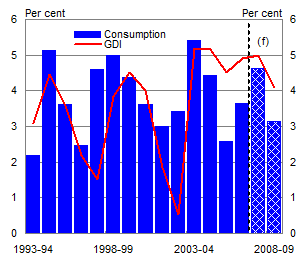
Source: ABS Cat. No. 5206.0 and Treasury.
Recent interest rate rises are expected to constrain consumption growth over the forecast horizon through the impact of higher interest payments on household budgets and by increasing the returns to saving. Additionally, recent financial market volatility in the wake of the US sub-prime mortgage crisis has created a more uncertain outlook for financial wealth, with the ASX200 falling by more than 15 per cent in the first three months of 2008. Consumer sentiment has declined sharply over this same period, with the Westpac-Melbourne Institute Index falling to its lowest level in almost 15 years.
Accordingly, consumption growth in 2008-09 has been revised down to 3¼ per cent (from 4 per cent at December JEFG).
Household disposable income is forecast to grow more strongly than consumption in 2008-09 (Chart 1), with the household sector expected to benefit from solid growth in salaries and wages, as well as strong growth in dividends associated with the rise in bulk commodity prices. Consistent with this, the household saving ratio is expected to consolidate its recovery in recent years, stabilising at around 2 per cent in 2008-09 (Chart 2).
Chart 2: Household Saving Ratio
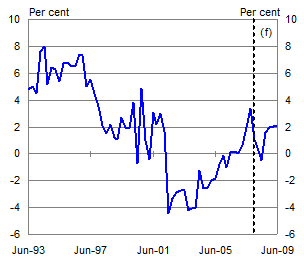
Source: ABS Cat. No. 5206.0 and Treasury.
Dwelling investment
Activity in dwelling investment is expected to be significantly weaker than at December JEFG, as successive interest rate rises weigh on this interest rate sensitive sector.
Since December JEFG, further increases in interest rates, including increases in rates independent of official rates due to the global financial market turmoil, have added around 80 basis points to the average standard variable home loan rate. The impact is expected to be felt particularly in new dwelling investment, with the nascent recovery in this sector deferred until after the forecast period, and only moderate growth expected in 2008-09 (Chart 3).
Chart 3: Dwelling investment (real)
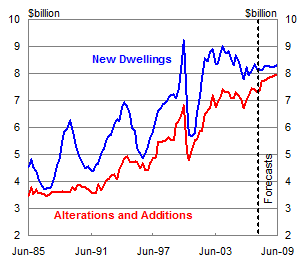
Source: ABS Cat. No. 5206.0 and Treasury.
Recent activity in the housing market has been concentrated in alterations and additions. Investment is expected to grow steadily over the forecast period albeit at a lower rate than at December JEFG, providing some support for total dwelling investment.
Underlying demand for housing is expected to remain strong, driven partly by a high level of migration, which has been supporting strong growth in house prices. Some moderation in house price growth is expected over the forecast period, reflecting weaker actual demand, as higher interest rates make housing less affordable. Nevertheless, constrained supply is expected to see house prices continue to grow faster than consumer prices. Less affordable housing and constrained supply imply continued tightness in the rental market and a continuation of record low vacancy rates, which are leading to rising rents.
Business investment
Following an increase of more than 100 per cent over the past six years, real new business investment is expected to continue to grow strongly in the forecast period, with an expected increase of 9½ per cent in 2007-08 and 8½ per cent in 2008-09. The overall outlook for business investment remains positive with capacity utilisation rates at high levels, a strong Australian dollar and further rises anticipated for the terms of trade. However, the forecasts are marginally weaker than at the December round amid an environment of higher borrowing costs.
In addition, business sentiment has weakened in recent months with the increased uncertainty in global financial markets and weaker growth in the world economy. These factors are expected to weigh on non-mining related investment in particular, with larger mining firms somewhat insulated from higher funding costs through their ability to fund projects from strong profits.
New business investment as a proportion of nominal GDP is expected to remain high (Chart 4).
Chart 4: Business investment to GDP ratio (nominal)

Source: ABS Cat. No. 5206.0 and Treasury.
New machinery and equipment investment
Investment in new machinery and equipment is expected to increase by 9½ per cent in 2007-08 and by 11 per cent in 2008-09. This continued strength is anticipated to be supported by a strong Australian dollar and expected rises in bulk commodity prices.
The outlook for 2007-08 is broadly unchanged from the December round. The December quarter 2007 Private New Capital Expenditure Survey (CAPEX) suggests positive investment intentions, particularly in the mining and construction industries in this year.
The weaker outlook for 2008-09 reflects the impact of higher interest rates on non-mining investment and an updated civil aircraft profile.
New non-dwelling construction investment
Total non-dwelling construction investment is expected to grow by 8½ per cent in 2007-08 and by 5½ per cent in 2008-09. The forecast for 2007-08 is lower than at December JEFG, reflecting weaker-than-expected outcomes for both engineering construction and non-residential buildings.
New engineering construction investment is expected to increase by 11½ per cent in 2007-08 and by 7 per cent in 2008-09. After recording another year of double digit growth in 2006-07, investment in engineering construction fell in the first half of 2007-08. However, the outlook remains positive with activity expected to ramp up with the recent commencement of significant projects such as the Pyrenees oil field and the expansion of the Yarwun alumina refinery.
Significant projects that are expected to commence in the forecast period include the Citic Pacific iron ore mine and pellet pla
nt, Gladstone Pacific Nickel’s refinery, and the Oakajee port and rail development.
A record amount of work yet to be done remains in the pipeline, but there remains a risk that constraints arising from increased cost and labour supply pressures will delay some engineering construction investment.
Non-residential buildings investment is expected to grow by 5½ per cent in 2007-08 and 4 per cent in 2008-09. Approvals data and low vacancy rates across the country suggest continued strength in activity in the office market. In addition, approvals data also suggest solid growth in retail and wholesale construction, and emerging strength in the tourist accommodation sector.
Inventories
Consistent with strong growth in domestic demand over the past year, private non-farm stocks are expected to contribute ¼ of a percentage point to GDP growth in 2007-08. Conversely, the forecast slowdown in domestic demand growth in 2008-09 is expected to result in stocks detracting from GDP growth by around ¼ of a percentage point in 2008-09.
Farm stocks are expected to have a negligible effect on GDP growth over the next two years.
Public final demand
New public demand has grown broadly in line with nominal GDP in recent times but is expected to fall as a proportion of the nominal economy over the forecast horizon (Chart 5).
Chart 5: Nominal public expenditure
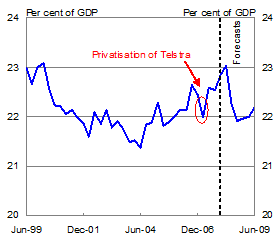
Source: ABS Cat. No. 5206.0 and Treasury
In real terms, new public final demand is expected to increase by 4¾ per cent in 2007-08 and 3 per cent in 2008-09, with expenditure at the State and Local level growing more strongly than at the Commonwealth level in both years (Table 3).
Table 3: Real new public expenditure
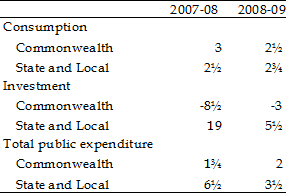
Source: Treasury.
The outlook for government consumption growth in both 2007-08 and 2008-09 is weaker relative to December JEFG. The weaker forecast for 2007-08 reflects lower growth expectations for State and Local consumption, while for 2008-09 it is due to moderating Commonwealth consumption.
New public investment is expected to record strong growth in 2007-08 before moderating to 4 per cent in 2008-09. Strong State and Local investment in 2007-08 is expected to drive public investment growth of 13¼ per cent. This is stronger than forecast at December JEFG, although there is a risk that project delays may transfer some growth from 2007-08 into 2008-09.
Exports, imports and the current account deficit
Following a 1¼ percentage point subtraction in 2006-07, net exports are expected to subtract 2 percentage points from GDP growth in 2007-08, a larger detraction than forecast at December JEFG, partly reflecting stronger-than-expected import growth in the December quarter 2007.
The expected subtraction for 2008-09 is now 1 percentage point, ¼ of a percentage point less than forecast at December JEFG in line with the lower expected domestic demand growth.
Total export growth in 2007-08 is forecast at 3 per cent and is lower relative to December JEFG, partly reflecting short term interruptions to mining activities associated with the Queensland floods. Export growth is then forecast to be 6 per cent in 2008-09, ½ of a percentage point higher than at December JEFG. This is partly attributable to a recovery in mining exports following the floods, but also reflects higher exports of rural commodities. A stronger rebound in rural exports is now expected in 2008-09 in line with a stronger recovery in the farm sector than previously expected.
Non-rural commodity exports are expected to increase by 5½ per cent in 2007-08 and by 7½ per cent in 2008-09 (Chart 6). Slower growth in coal exports in 2007-08, associated with the severe flooding in Queensland, has resulted in a downward revision to the 2007-08 forecast from December JEFG. The acceleration in non-rural commodity exports growth in 2008-09 reflects mining projects coming online following the large amount of investment undertaken in recent years, and a recovery from weather-affected export growth in 2007-08.
Chart 6: Non-rural commodity exports (year average)

Source: ABS Cat. No. 5302.0, and Treasury.
Growth in iron ore exports is expected to contribute significantly to non-rural commodity export growth over the forecast period, as new entrants join existing producers to ramp up production. After recording solid growth of 7.3 per cent in 2006-07, iron ore export volumes are forecast to grow by 12½ per cent in 2007-08 and by 12 per cent in 2008-09. Mineral fuels are also expected to contribute strongly in 2008-09 as oil and gas projects come online.
After a weak 2008-09, the outlook for farm production has improved for 2008-09. While the strong rainfalls received across much of Eastern Australia in February came too late to affect the 2007-08 winter crop, they have dramatically improved the outlook for 2008-09. Farm production is expected to grow by 20 per cent in 2008-09, reaching around 95 per cent of the pre-drought level of 2005-06. Growth is expected to be primarily driven by an increase in the production of cereal crops such as wheat and barley. Livestock production is expected to remain relatively flat, as increased herd rebuilding largely offsets decreased livestock slaughterings.
Rural exports are forecast to fall by 9½ per cent in 2007-08, reflecting drought-affected farm production in 2006-07 and 2007-08, and low levels of farm inventories which have historically supported exports in years of below-average production. In 2008-09, the forecast for rural exports has been revised upwards in line with higher farm output, with expected growth of 12½ per cent.
While more favourable supply conditions should improve our commodity exports, other exports are expected to be adversely affected by a sustained higher exchange rate and slower world growth.
Exports of elaborately transformed manufactures are forecast to slow from growth of 7½ per cent in 2007-08 to ½ of a per cent in 2008-09. Growth in 2007-08 is stronger than forecast at December JEFG, underpinned by strong outcomes for pharmaceutical exports and motor vehicle sales. Services exports growth, while showing some strength in 2007-08, is expected to be sluggish in 2008-09.
Imports of goods and services are expected to increase by 11 per cent in 2007-08, higher than December JEFG, supported by the higher exchange rate and robust consumption and investment demand. However, an easing in domestic demand growth in 2008-09, especially in relation to household consumption, is expected to dampen import growth to 9 per cent, slightly lower than forecast at December JEFG.
Expected growth in goods imports is higher relative to the December JEFG in 2007-08, but has been revised down in 2008-09 reflecting a downward revision to domestic demand. Imports of capital goods are expected to
hold up, however, in line with continued strong growth in business investment. Services imports growth is expected to be stronger in 2007-08 than at December JEFG, reflecting robust demand for outbound travel and professional services and a higher exchange rate. In 2008-09, services imports growth is expected to moderate, in line with domestic demand.
The terms of trade are forecast to increase by 4¾ per cent in 2007-08 and by 16 per cent in 2008-09, up from forecast rises of 1¾ per cent and 4½ per cent at December JEFG (Chart 7). The strong upward revisions, which follow upward revisions at December JEFG, predominantly reflect increasingly tight markets for bulk commodities, leading to very substantial increases in contract prices in 2008-09. Contract prices for Australian iron ore will increase by at least 65 per cent, while prices for metallurgical coal and thermal coal have surged by around 200 per cent and 125 per cent respectively. Strength in prices for Australia’s bulk commodity exports is expected to more than offset significant expected falls in some base metal prices.
Chart 7: Terms of trade
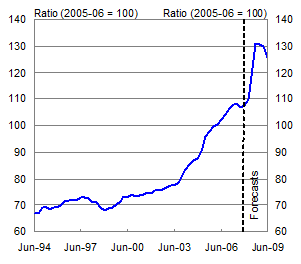
Source: ABS Cat. No. 5302.0 and Treasury.
The trade deficit is expected to widen to 1¾ per cent of GDP in 2007-08, unchanged from December JEFG, with a widening deficit in trade volumes offsetting a higher terms of trade. In 2008-09 the trade balance is expected to move into surplus, to be ¾ of a per cent of GDP, reflecting a substantial increase in export values on the back of higher bulk commodity prices.
The net income deficit (NID) as a per cent of GDP in 2007-08 is expected to remain broadly unchanged from 2006-07, before widening to 5¼ per cent in 2008-09. The widening in 2008-09 largely reflects a rising stock of net foreign debt and robust growth in corporate profits, with particularly strong growth in mining profits. However, given the current uncertainty in financial markets, the outlook for the NID is more uncertain than usual.
Reflecting these movements, the current account deficit (CAD) is expected to be 6¼ per cent of GDP in 2007-08, narrowing to 4½ per cent of GDP in 2008-09 (Chart 8). The forecast for 2008-09 is 2 percentage points of GDP narrower than at December JEFG.
Chart 8: Current account balance
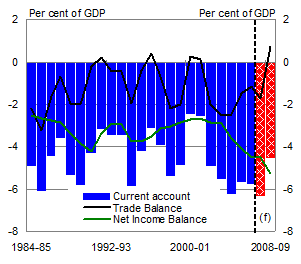
Source: ABS Cat. No. 5302.0, 5206.0 and Treasury.
Employment, wages and inflation
Labour market
Employment is forecast to grow by 2½ per cent in 2007-08, unchanged from December JEFG, before easing to 1¼ per cent in 2008-09, ½ of a percentage point lower than at December JEFG. The moderation in 2008-09 reflects a weaker forecast for non-farm GDP growth.
Chart 9: Labour market indicators

Source: ABS Cat. No. 6202.0 and Treasury
The participation rate is expected to fall slightly from the current record level of 65¼ per cent to 65 per cent by the June quarter 2009, as the supply of labour starts to respond to the easing in labour demand (Chart 9). The high participation rate in 2007-08 and the first half of 2008-09 is expected to be supported by continuing increase in skilled immigration.
The forecasts for the unemployment rate have been revised down in 2007-08 to 4¼ per cent, from 4½ per cent at December JEFG, reflecting recent low unemployment rate outcomes. The unemployment rate is forecast to increase slightly to 4¾ per cent by the June quarter 2009, in line with a moderation in employment growth towards the end of 2008-09.
Prices
Inflationary pressures are expected to persist across the forecast horizon, with headline CPI expected to grow by 3½ per cent through the year to the June quarter 2008 and 3 per cent to the quarter June 2009. In both years this is ¼ of a percentage point higher than December JEFG. The upward revisions are largely driven by higher expected nominal unit labour costs and higher oil prices.
Inflation is expected to peak in the March quarter 2008 at 4 per cent, before easing to near the top of the RBA target band by the June quarter 2009. In the near-term, this reflects price pressures from strong nominal unit labour costs and high oil prices, as well as specific price pressures from food, housing costs and financial services. Underlying inflation is expected to follow a similar path, remaining high over the forecast period (Chart 10). The RBA’s trimmed mean measure of underlying inflation is expected to peak at around 3¾ per cent in March 2008, easing to 3 per cent by the June quarter 2009, in line with slowing domestic demand and output.
Growth in dwelling rents are expected to be strong, reflecting record low vacancy rates, and growth in house purchase prices is likely to remain solid due to increasing labour and material costs. Financial services prices are also expected to grow strongly in the near term due to the combined effects of higher interest rates from continued turmoil in global financial markets and recent official interest rate rises. The price of food is expected to remain at high levels in the near-term given strong world demand and constrained domestic supply following severe drought, although the expected recovery in farm production may place downward pressure on domestic food prices.
Chart 10: Consumer price inflation
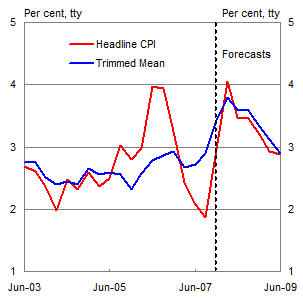
Source: ABS Cat. No. 6401.0 and Treasury.
Wages
Solid wage growth is expected across the forecast horizon, but is not forecast to accelerate, given the anticipated easing in labour market conditions. The Wage Price Index (WPI) is forecast to grow by 4¼ per cent in 2007-08 and 2008-09, with growth of 4¼ per cent through the year to both the June quarters 2008 and 2009.
There continues to be a geographical dispersion in wage growth across the economy, largely attributable to the mineral price boom since 2004. Through the year to the December quarter 2007, wages growth in Western Australia accelerated to 5.9 per cent, 2 percentage points higher than corresponding wage growth in New South Wales and Victoria. This wage divergence at the state level partly reflects strong growth in the mining and construction industries of 5.1 per cent and 4.6 per cent through the year respectively. The expected further increase in mineral export prices is likely to sustain these divergences in wages growth over the forecast horizon.
To date, rapid wages growth in the mining and construction industries has not led to a similar acceleration in other industries. The WPI has remained strong but relatively stable. However, the possibility of a spillover of wage pressure from the mining and construction industries resulting in overall faster wages growth continues to be a risk.